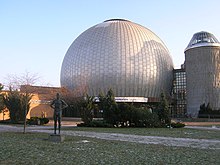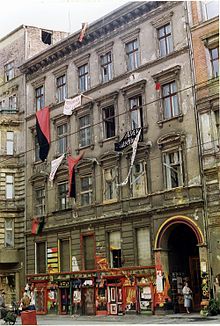Prenzlauer Berg
You can help expand this article with text translated from the corresponding article in German. (February 2009) Click [show] for important translation instructions.
|
Prenzlauer Berg | |
|---|---|
Ortsteil of Berlin | |
 Kastanienallee/Schönhauser Allee | |
| Coordinates: 52°32′21″N 13°25′27″E / 52.53917°N 13.42417°E | |
| Country | Germany |
| State | Berlin |
| City | Berlin |
| Borough | Pankow |
| Area | |
| • Total | 10.955 km2 (4.230 sq mi) |
| Elevation | 91 m (299 ft) |
| Population (2020-12-31)[1] | |
| • Total | 165,055 |
| • Density | 15,000/km2 (39,000/sq mi) |
| Time zone | UTC+01:00 (CET) |
| • Summer (DST) | UTC+02:00 (CEST) |
| Postal codes | (nr. 0301) 10405, 10407, 10409, 10435, 10437, 10439, 10119, 10247, 10249 |
| Vehicle registration | B |
Prenzlauer Berg (German pronunciation:
From the 1960s onward, Prenzlauer Berg was associated with proponents of
Geography
Prenzlauer Berg is a portion of the Pankow district in northeast Berlin. To the west and southwest it borders
Geologically, the borough straddles the southernmost edge of the Barnim glacial deposit formed during the last Ice Age. Prenzlauer Berg (literally Prenzlau Hill) was always seen as a hill by the inhabitants of historic Berlin situated to the south in the glacial valley along the river Spree. Until the 20th century the area was mostly referred to as "Windmill Hill".
The highest point of the district is 91 meters above sea level in the northwest of Volkspark Prenzlauer Berg. This hill consists of the rubble from buildings that were destroyed in
Cityscape
Prenzlauer Berg is characterized by Wilhelmine buildings, that were erected at the turn of the 20th century (1889 to 1905). Over 80% of all housing in this area was constructed before 1948, with the oldest building still standing being from 1848 at Kastanienallee 77. Though substantial, there was less war-related destruction here than in other parts of the city, which were almost entirely wiped out by the allied bombing campaign.

Apart from the apartment buildings in the area around Ostseestraße built in the 1950s characterized by the architectural style of
During

Prenzlauer Berg is an almost homogeneous historic building area in which much of the pre-war architecture has been preserved and where there are still many cobbled streets and ornate buildings from the beginning of the 20th century.
Over 300 buildings remain protected as historic monuments, like the municipal swimming pool at Oderberger Straße and the breweries on Milastraße and Knaackstraße. The borough is famous for its restaurants and bars.[citation needed] Although places that provide a truly traditional Berlin staple are few and far between, there is a vast array of restaurants offering Arab, Turkish, Vietnamese, Tex-Mex, and Italian cuisine, especially around Kastanienallee, Kollwitzplatz, and Helmholtzplatz. The area around the intersections of Schönhauser Allee, Danziger Straße, Eberswalder Straße, Kastanienallee and Pappelallee has been associated with youth culture since the 1950s, and was immortalised in the DEFA film Ecke Schönhauser.
With regard to urban planning, the district affords a relatively uniform picture. It is predominantly characterized by five-story, multiple dwelling units in closed blocks. Thanks to the long property lots, the blocks, more often than not, are large and have abundant backyards, some having a perimeter of more than a kilometer.
Notable buildings include the large churches of the district, of which Gethsemane Church (designed by August Orth and built in 1891–1893) at Stargarder Straße is best known for its role in the peaceful revolution that brought down the Wall in 1989. Its 66-metre (217 ft) steeple is surpassed locally only by that of Segenskirche on Schönhauser Allee (79 metres (259 ft)) and of Immanuelkirche on Prenzlauer Allee (68 metres (223 ft)). School buildings planned by Ludwig Ernst Emil Hoffmann (1852–1932) also stand out in the area.
The largest synagogue in Germany is

A landmark in Prenzlauer Berg is the former water tower "Fat Hermann" at the corner of Rykestraße and Knaackstraße near Kollwitzplatz. Built in 1877, it is the first water tower in Berlin.[citation needed] Historic buildings like the water tower, or the Prater Beer Garden in Kastanienallee, as well as the former brewery at Schönhauser Allee and Sredzkystraße still give an impression of the days when Prenzlauer Berg was part of the so-called Steinernes Berlin (Berlin of stone) as described by author Werner Hegemann in 1930.[citation needed] Another notable building is the Zeiss-Großplanetarium on Prenzlauer Allee, opened in 1987.
In the west, bordering the borough of
History
This section needs additional citations for verification. (June 2017) |
Prenzlauer Berg was developed during the second half of the 19th century based on 1862
During the war years the city population decreased as many inhabitants were evacuated to the countryside to escape aerial bombardment. When the city was divided by the allies, Prenzlauer Berg became part of the
Prenzlauer Berg at the time of the German reunification

In the interim between the peaceful revolution that brought down the wall in 1989 and the consolidation of a united Germany that began a year later, as many as 39 Wilhelmine apartment houses were occupied by
Most of Prenzlauer Berg's urban apartment blocks had belonged to the state-owned
Prenzlauer Berg since the 1990s

After the fall of the Berlin Wall, Prenzlauer Berg initially developed into a trendy district with numerous cafés, bars and clubs, especially in the streets around Kollwitzplatz and Helmholtzplatz, due to numerous vacant commercial spaces in the early 1990s. However, these early underground bars and clubs disappeared already in the mid-1990s with the increasing redevelopment and gentrification of the district. Apart from a few commercial discotheques in the Kulturbrauerei, there are no more clubs in Prenzlauer Berg since the 2010s.[6] After the turn of the millennium, Prenzlauer Berg, with its now overpriced rents, stylish bars and chic stores, was soon regarded by many as the "spearhead of Berlin's gentrification" and as the "bourgeois area of the new Berlin".[7]
Along with
Over the years many
Points of interest
- Gethsemane Church, former meeting place of the resistance in the GDR
- The area around Helmholtzplatz and along Kastanienallee for restaurants and bars
- Kollwitzplatz on market days
- The Jewish cemetery on Schönhauser Allee, where painter Max Liebermann and composer Giacomo Meyerbeer are buried
- The former breweries Pfefferberg."
- Mauerpark (flea market every Sunday, open air concerts during summer months)
- Rykestrasse Synagogue
- Wasserturm Prenzlauer Berg (water tower), designed by Henry Gill, constructed by the English Waterworks Company and finished in 1877.
People
- Kurt Demmler (1943–2009), songwriter accused of sexual abuse who hanged himself in his jail cell.
- Heinz Kapelle (1913–1941), communist
- Ernst Knaack, (1914–1944), resistance fighter
- Christian Lorenz (born 1966), musician and keyboard player for band Rammstein
- Käthe Niederkirchner (1909–1944), resistance fighter
- Wilhelm Rietze (1903–1944), resistance fighter
- Hans Rosenthal (1925–1987), radio editor, director, and one of the most popular German radio and television hosts of the 1970s and 1980s.
- Gustav Scholz (1930–2000), boxer
- Cornelia Schleime (born 1953), painter, performer, filmmaker and author
- Arthur Sodtke (1901–1944), resistance fighter
- Ernst Thälmann (1886–1944), communist politician
- Agnes Wendland (1891–1946), Righteous Among the Nations
References
- ^ "Einwohnerinnen und Einwohner im Land Berlin am 31. Dezember 2020" (PDF). Amt für Statistik Berlin-Brandenburg. February 2021.
- ^ Wolfgang Benz & Barbara Distel (edd.), Der Ort des Terrors: Geschichte der nationalsozialistischen Konzentrationslager, band II, München: Beck, 2005, p. 52.
- ^ Berlin Besetzt – Historical interactive map of Berlin squats in German and English [1]
- ^ Hausbesetzer – Selbstdarstellung von 16 Projekten aus Friedrichshain, Mitte und Prenzlauer Berg [2]
- ^ Peter Beaumont, "East Berlin fights back against the yuppy invaders: The German capital is divided once again, as residents of the former east are forced from their homes by gentrification," The Guardian (16 January 2011); Retrieved 19 January 2011
- ^ Scherff, Victoria (31 January 2019). "Prenzlauer Berger Clubleben: Früher ideell, heute kommerziell?" [Prenzlauer Berger club life: Formerly idealistic, now commercial?] (in German). Prenzlauer Berg Nachrichten. Retrieved 17 January 2024.
- ^ Sontheimer, Michael; Wensierski, Peter (11 March 2018). "Prenzlauer Berg: Vorm Soja-Chai-Latte war hier noch Punk" [Prenzlauer Berg: Before the soy chai latte, there was still punk here]. Die Zeit (in German). Retrieved 17 January 2024.
- ^ Henning Sußebach (7 November 2007). "Bionade-Biedermeier". Zeit Online. Retrieved 26 September 2015.
- ISBN 978-0-241-46726-8.
External links
- tic-berlin: tourist & historical information about Prenzlauer Berg
- Prenzlberger Stimme (News and opinions from Prenzlauer Berg in German)
- Prenzlauer Berg Nachrichten (the local blog in German)
- BBC article about the baby boom in Prenzlauer berg
- Herald Tribune Article about Berlin and Prenzlauer Berg
- Historical interactive map of Berlin squats in German and English




